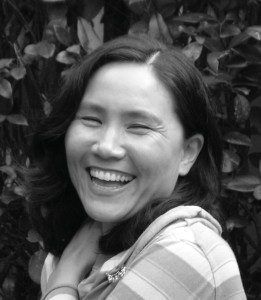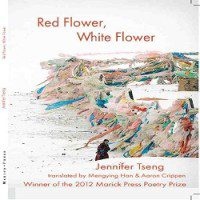Whenever I get my hands on a book of translated poems that includes the original, I am extra pleased. I let the Spanish, French, or Turkish imperfectly roll off my tongue, imagining what the poet was thinking and feeling as they wrote the poems. I read the English version and ponder it, but there is something about originals in the poet’s language that holds emotions or intent that even the best translators can never fully draw out.
Jennifer Tseng’s Red Flower, White Flower made me wish I could read Chinese characters to continue my usual practice. The translated poems are beautiful, relatively short, seemingly simple. I wonder what they would sound like in Chinese, what depth might be hidden in their true language. This is what I love about poetry, and Tseng has written the kinds of poems I love most to read, but I can only judge them in English and I fear this probably does not do them justice.
Red Flower, White Flower connects poems about love, loss, navigating a variety of types of relationships, the ending of relationships, communication, and loneliness. In “Questions for Darkness”, she begins:
Can it be that once I loved
you as one loves a garden,
the known & the wild,
together with the forgotten?
The poem ends with:
Who were you & how
can I find you now?
This is the universal question of love, what all lovers, and as poets are the ultimate lovers, perhaps all poets, ask in our own languages and a multitude of ways. This is The Question. I have asked something akin to this not only of past lovers, but also of my now-grown child and even of my own self as I have changed over the years.
The book is broken into three sections. The first section, “Red Flower” is full of poems about early love. It speaks to the past, to yearnings, to confusions, and sometimes painful lessons.
The central section, aptly titled “The Fabled Bridge”, is a poetic prose account of the lifespan of a woman. It is complex and it leads the reader to have questions, but those questions do not have answers. The section serves as a bridge between two cultures, a duality (two fathers, two mothers, two lovers, more). On one end you have the red flower, a life – in this case a childlike innocence and questions about love. On the other end you have the white flower, another life, the wiser and more complex reflections apparent in the “White Flower” portion of the collection. In between is the bridge between spaces and places. Reference to the sea begins in this bridge section and continues into the “White Flower”. Perhaps the sea is the bridge, when one looks forward to the future home of expected immigration, and when one then looks backwards to the home of birth, evaluating all that has gone between. Tseng writes later:
My father
an immigrant, named me
for the sea.
This reconciliation of both worlds by the immigrant’s child is why a bridge is needed, just as the reconciliation between the thoughts of a younger lover and an adult looking back over their life.
From the ending of “The Fabled Bridge”:
It was there by the sea that she made her home. Standing one morning… she couldn’t help but see the heavy teardrops as tragic…
The third and final section of the book, “White Flower” begins:
I wanted to write about the world, but I had never traveled.
I wanted to write about sweat, but I had done nothing difficult.
I wanted to write about beauty, but I had no eye for it.
“White Flower” is the adult Tseng, rethinking the past, moving in the present, looking towards the future. This section is really about hope. It is about taking the lessons learned, integrating them with family stories, myth, and legends, and moving forwards into new life and new love.
Many books of poetry follow this format of childlike innocence/young love, a middle section that works thru disappointments, and an older, wiser, but not bitter final section. It’s not an especially unique form, but Tseng makes it her own by breaking from strictly poetry into prose and storytelling in “The Fabled Bridge”. There is a flow, like the sea she frequently references, that makes the book comforting.
There is a deception of simple language in Red Flower, White Flower. It carries, even in the English, a hint of musical notes, and, of course, the thread of flowers & sea running throughout the book integrate natural elements. The poems are not complicated to relate to. There is no tension-producing obscurity, no difficult to place references that frustrate contextualization. This is refreshing. Yet they ring in the mind after the reading. The weight of the poems seems light upon first reading, but then you are drawn back again and again, asking of yourself, and of the poet, “How much deeper does this go?”





One response
Name the translators! What you read was not most imminently made by Jennifer Tseng — it was written by Mengying Han and Aaron Crippen. Recognize their work — it’s as important to you as the poet’s original!
Click here to subscribe today and leave your comment.